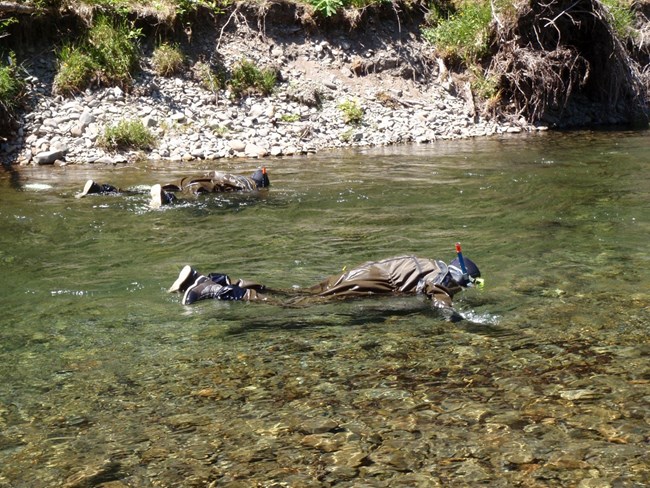
NPS Photo Importance & IssuesRivers and streams that drain from Olympic, Mount Rainier, and North Cascades National Parks are among the most protected corridors in the lower 48 states. They represent some of the largest tracts of continuous, undisturbed habitat throughout the range of several key fish species of the Pacific Northwest. Fishery resources in many park rivers, particularly those that drain from Olympic National Park, are ecologically and culturally important and contribute to economically important recreational, commercial, and tribal fisheries. Monitoring ObjectivesThe seasonal movements, assemblage structure, and relative abundances of fish species are determined by summer weekly snorkel counts in reference sites of each river each year. The objective of repeated snorkel surveys in relatively long sample sites (2.6 to 5.7 km) is to examine seasonal and annual changes in abundances of the primary species. The rationale for intensive sampling (up to 10 surveys per river per year) of reference sites is to account for the high seasonal variability in fish movements and abundances in rivers. To detect seasonal and annual trends in fish communities in reference sites, we rely on repeated and consistent annual sampling using the same methods at each monitoring location. Specific objectives are to:
Sampling ApproachFisheries biologists conducted the most intensive monitoring efforts to date of fish communities in NCCN rivers with n=351 snorkel surveys from 2005 to 2010. Fisheries crews snorkeled ~1,400 river kilometers in reference sites of the Bogachiel, Calawah, Dosewallips, Elwha Hoh (South Fork), Skokokmish, Quinault, and Sol Duc Rivers. Biologists made 129,558 individual fish observations during that time. In total, we monitored 14 fish species across the 10 rivers and 11 of the 14 fish species were Pacific salmonids. Management ApplicationsFish communities that inhabit park rivers serve as important benchmarks that define natural limits of variation, and monitoring can identify where management actions are necessary. A key to understanding fish communities in North Coast and Cascades Network rivers is the collection of temporally consistent information on an annual basis. Reports, Documents, and Datasets |
Last updated: July 16, 2025
